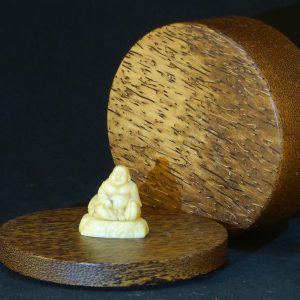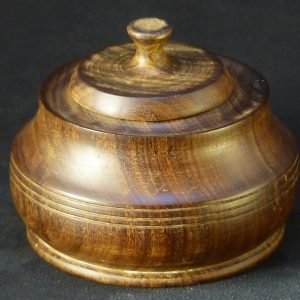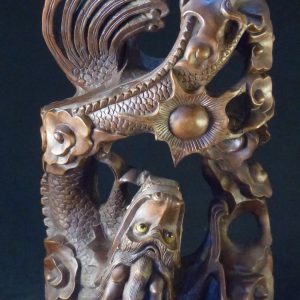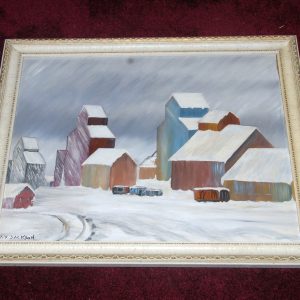Description
油畫 雪景
参考:Sotheby
IMPORTANT CANADIAN ART
58 Alexander Young Jackson 1882 – 1974
ST. TITE DES CAPS
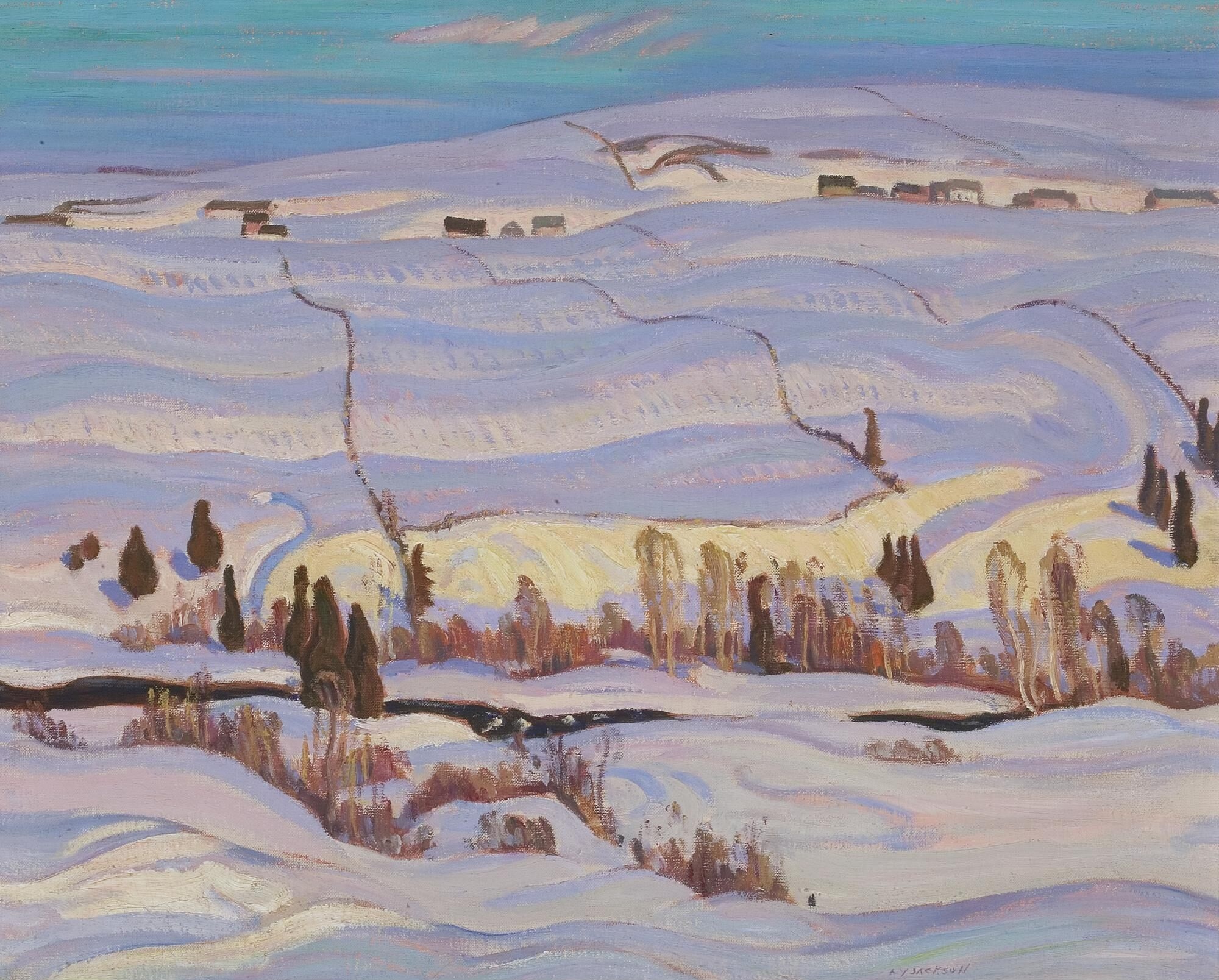
ST. TITE DES CAPS
Estimate 250,000 — 350,000 CAD
Alexander Young Jackson
1882 – 1974
ST. TITE DES CAPS
signed l.r.: A. Y. Jackson; signed, titled and dated by the artist on the stretcher: A.Y. Jackson, St. Tite des Caps, Dec. 1939; titled on a label on the stretcher: Morning, St. Tite des Caps
oil on canvas
66.0 by 81.3 cm. 26 by 32 in.
PROVENANCE
Private Collection, Ottawa
CATALOGUE NOTE
Jackson’s annual trip down the shores of the St Lawrence in early spring produced a steady stream of inspired oil sketches and canvases, especially through the 1920s and 1930s. This view near St. Tite des Caps, probably in late March, is a particularly fine and ambitious example of his work in these areas of Quebec. Jackson has tackled a large and difficult scene, a vast expanse of snow, which is practically unbroken except for the stream with a few straggly trees and a sparse line of small farm buildings along a distant ridge. Yet with his characteristic undulating lines that define the contours of the topography both near and far, and his adaptation of an impressionist palette that he had developed for himself after his time in France, he has made every part of this canvas intriguing and vital. The long fence lines, which demarked the property allocations from the river shore well up into the high country, and the hint of ploughed furrows almost visible under a mantle of late spring snow, add further to the complexity of the composition. Arching over the entire vista is a lively aquamarine sky.
参考:Sotheby
IMPORTANT CANADIAN ART
71 Alexander Young Jackson 1882 – 1974
THE ROAD TO RIPON
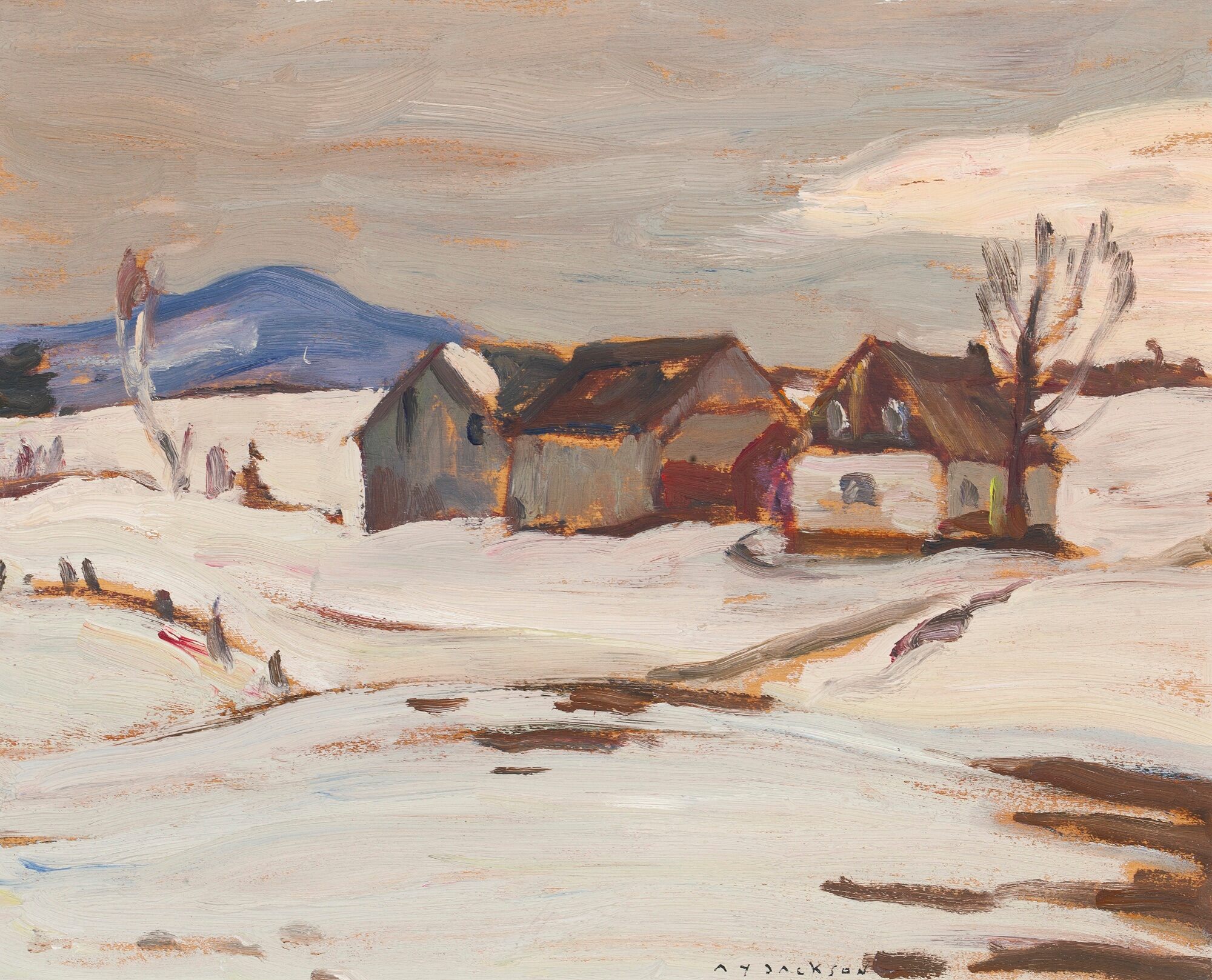
THE ROAD TO RIPON
Estimate 18,000 — 22,000 CAD
LOT SOLD. 20,400 CAD
Alexander Young Jackson
1882 – 1974
THE ROAD TO RIPON
signed lower right; signed, titled and dated March 1950 on the reverse
oil on panel
21.6 by 26.7 cm.
8 1/2 by 10 1/2 in.
PROVENANCE
Private Collection, Ontario (by descent to the present owner)
CATALOGUE NOTE
According to the present owner, this work was acquired by his father who was introduced to the artist by a mutual friend.
参考:Sotheby
IMPORTANT CANADIAN ART
148 Alexander Young Jackson 1882 – 1974
MINER’S COTTAGES, COCHENOUR-WILLANS MINES, RED LAKE COUNTRY
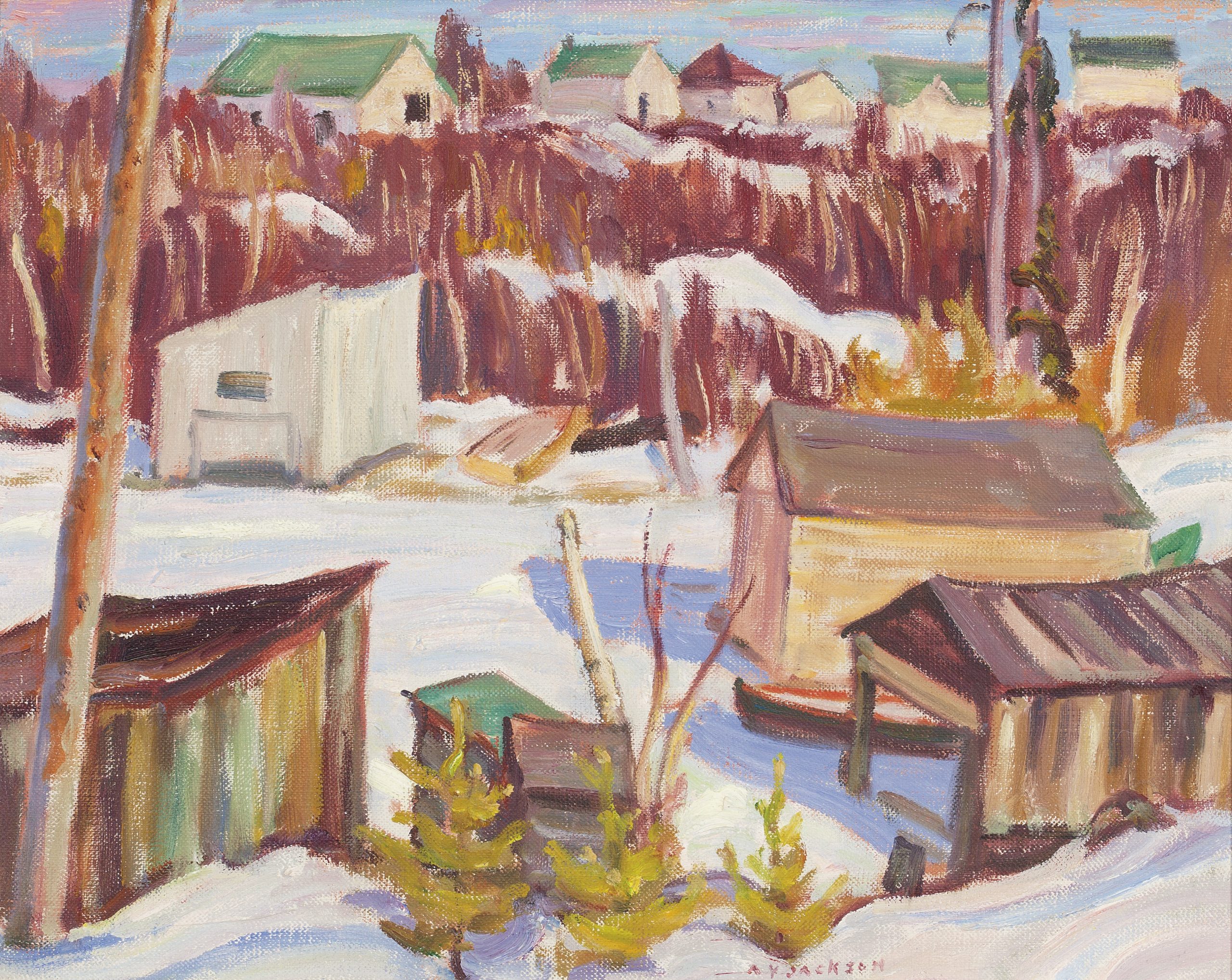
MINER’S COTTAGES, COCHENOUR-WILLANS MINES, RED LAKE COUNTRY
Estimate 40,000 — 60,000 CAD
LOT SOLD. 45,000 CAD
Alexander Young Jackson
1882 – 1974
MINER’S COTTAGES, COCHENOUR-WILLANS MINES, RED LAKE COUNTRY
signed lower right; titled and dated 1953 on the stretcher
oil on canvas
41 by 51 cm.
16 by 20 in.
PROVENANCE
Kaspar Gallery, Toronto
Private Collection, Vancouver
CATALOGUE NOTE
Jackson liked to travel into remote northern mining sites for a variety of reasons. First, he liked to document as much of Canada’s varied landscapes as he could. In this respect he was much more thorough than his other colleagues in the Group of Seven, only one or two of whom actually got to every region of the country.
Second, Jackson was virtually guaranteed to find subjects for him to paint, and especially at mining sites, which were concrete examples of Canadians hard at work. The great economic drivers of the time were mining, lumber, agriculture, and fishing. These were the activities that Jackson and his colleagues were drawn to as valid subjects in their quest to portray the character of Canada.
Finally (and practically), Jackson liked to set up a visit ahead of time so that he could hitch a ride on a plane, and have a place to sleep and eat, usually free or at least in exchange for a sketch or two. As well, the possibility existed that he might sell a large canvas of the mine site to one of the executives of the company back in Toronto or Montreal.
This particular painting of the famous Cochenour-Willans Mine in the Red Lake district in northern Ontario is a vivid one that shows the miners’ cottages there. The mine was a great gold producer for a very long time, and Jackson’s record of it is a fine memorial to its now-faded reputation.
A.Y. Jackson, 1882-1974
A.Y. Jackson was a towering figure in Canadian art, shaping our nation’s sense of identity through his paintings
Biography
A.Y. Jackson played a leadership role in 20th century Canadian art, including:
Serving as an official war artist during the First World War;
Being a friend and influencer of Tom Thomson;
Being a founding member of the Group of Seven;
Being a founding member of the Canadian Group of Painters;
Initiating the Sampson-Matthews Ltd. silkscreen project;
Alexander Young Jackson was born in 1882 in Montreal.
As a teen, A.Y. Jackson worked in lithography, a printing house and a photo-engraving shop, gaining skills and experience that he would later use as an artist.
While in Montreal, A.Y. Jackson studied under William Brymner at the Art Association of Montreal.
But, like many artists of his day, A.Y. Jackson looked to Europe for inspiration. At the age of 23, he worked his passage on a cattle boat to Europe, where he visited London and Paris.
After returning to Montreal, A.Y. Jackson soon went to study at The Art Institute of Chicago, taking classes at night, while working in a design firm during the day. He earned enough to return to Paris, where he enrolled in Académie Julian. He also travelled to Italy to visit museums.
A.Y. Jackson made several other trips back and forth to Europe, where he was influenced by the French Impressionists.
Upon returning to Montreal again, A.Y. Jackson exhibited jointly with Randolph Hewton at the Montreal Museum of Fine Arts, though Jackson’s French Impressionistic paintings found few buyers.
Future Group of Seven Members
It was during this period before the First World War, that A.Y. Jackson first met artists J.E.H. MacDonald, Lawren Harris – who purchased one of Jackson’s paintings – Arthur Lismer, Frederick Varley, and other members of the Arts and Letters Club of Toronto.
While on a sketching trip to Georgian Bay, A.Y. Jackson also met Dr. James McCallum, a friend of Lawren Harris and an arts partron. Dr. James McCallum offered A.Y. Jackson space in the Studio Building, which was being built in Toronto by McCallum and Harris.
Soon after, A.Y. Jackson met Tom Thomson, who had also been befriended by Dr. James McCallum. The two artists were soon sharing space in the Studio Building, A.Y. Jackson sharing his stories of his European travels and the art scene there, Tom Thomson sharing his love for Algonquin Park.
A.Y. Jackson was inspired to visit Algonquin Park himself in 1914, where he sketched with J.E.H. MacDonald, J.W. Beatty and Tom Thomson. It was while camping with Tom Thomson that A.Y. Jackson made his first sketch for his painting The Red Maple (in the National Gallery of Canada).
Official War Artist
The First World War called and A.Y. Jackson enlisted in 1915, serving as a private overseas. He was wounded and invalided to England, where he was soon given the job as an Official War Artist with the Canadian War Records by Lord Beaverbrook (Canadian Max Aitken).
As a Canadian war artist, A.Y. Jackson painted many scenes of barren and tortured landscapes. The paintings are held by the National Gallery of Canada, including Vimy Ridge from Souchez Valley; Gas Attack, Lievin; Trenches Near Angres; and a number of portraits.
A.Y. Jackson was discharged in April of 1919 and returned to Toronto, where he renewed his friendship with other Canadian artists who were eager to travel to Ontario’s north country to paint. Tom Thomson, who had died in 1917, was with them in spirit. A.Y. Jackson also joined the Royal Canadian Academy of Art that year.
In May 1920, the first Group of Seven exhibition opened at the Art Gallery of Toronto, featuring works by Lawren Harris, Arthur Lismer, J.E.H. MacDonald, Frank Carmichael, Frank (Franz) Johnston, Frederick Varley and A.Y. Jackson.
Randolph Hewton, Robert Pilot and Albert Robinson (who had once travelled to Europe with A.Y. Jackson) exhibited works as well, but weren’t members of the Group.
Exhibit Met with Controversy
The Group of Seven exhibition was received with great controversy and even derision, with A.Y. Jackson’s painting Terre Sauvage causing a storm.
The Group continued to exhibit until 1931, with each show facing criticism from critics who couldn’t see past their “traditionalist” views to recognize the colourful beauty of Canada’s wild landscape shown in their ground breaking paintings. Some works were dismissed as “freakish.”
In contrast to the hostility Group of Seven works faced in Canada, they were praised when shown by the National Gallery of Canada at the Wembley Exhibition in 1924 England. The Tate Gallery purchased A.Y. Jackson’s Entrance To Halifax Harbour, a war painting. The purchase made headlines back in Canada.
In 1927, A.Y. Jackson travelled with Dr. Frederick Bantin – the co-discoverer of insulin was also a Canadian artist – on a steamship that was delivering supplies to RCMP posts in the far north, visiting Ellsmere Island and other places in the Arctic.
A.Y. Jackson took a second Arctic trip on the same ship with Lawren Harris in 1930. When they returned home, an exhibition of their Arctic sketches took place at the National Gallery of Canada. The exhibition was also shown at the Montreal Museum of Fine Arts and the Art Gallery of Toronto.
Canadian Group of Painters
A.Y. Jackson resigned from the Royal Canadian Academy in 1932 as a protest to the Academy’s unsympathetic view of younger artists, as well as for its unwillingness to accept the shift in Canadian painting styles.
In 1933, the remaining original members of the Group of Seven decided that they should disband (J.E.H. MacDonald had died in 1932, while others had left the group, and new members had joined: A.J. Casson, Lionel FitzGerald and Edwin Holgate).
A.Y. Jackson was a founding member of a new group called The Canadian Group of Painters, made up of more than 40 members.
In the following years A.Y. Jackson continued to travel to virtually every corner of Canada: to numerous locales in the Arctic, Quebec, Ontario, Alberta, British Columbia, Newfoundland and elsewhere. Quebec and the Arctic were favourite spots throughout his long life.
When the Second World War broke out, A.Y. Jackson initiated a plan to reproduce Canadian paintings to boost troop morale. He worked with the National Gallery of Canada to get the project off the ground, with works hand-produced using a silkscreen process by the Sampson-Matthews Ltd. company of Toronto (see blog post on Sampson-Matthews project).
Sampson-Matthews Project
A.Y. Jackson and A.J. Casson, both of whom worked for Sampson-Matthews, had a large say in which artworks were reproduced, and they also commissioned new works by lesser-known artists.
In 1953, a large exhibition of A.Y. Jackson paintings took place at the Art Gallery of Toronto and the National Gallery of Canada, with the catalogue written by Arthur Lismer.
A.Y. Jackson maintained his headquarters in the Studio Building in Toronto until 1955, when he moved to Manotick.
In his autobiography, A.Y. Jackson explained that he had become familiar with the Gatineau area, north of Ottawa, where he had sketched with Ralph (R.W.) Burton and Maurice Haycock and had found an ideal country full of lakes, rivers and old settlements. At Manotick, A.Y. Jackson was also close to his niece, Naomi Jackson Groves, also an artist.
A.Y. Jackson suffered a stroke in 1965, and he lived some of his final years at the McMichael Conservation estate in Kleinburg (now the McMichael Collection of Canadian Art gallery). He died in 1974 in his 91st year.
During his lifetime, A.Y. Jackson received numerous honours, including honorary degrees from several universities and the Order of Canada (1968).
A.Y. Jackson’s paintings are held in numerous collections.
Source: A Dictionary of Canadian Artists, volumes 1-8 by Colin S. MacDonald, and volume 9 (online only), by Anne Newlands and Judith Parker. National Gallery of Canada, Artists in Canada database.

![[临渊阁]天地一家春](https://www.antiquekeeper.ca/wp-content/uploads/2023/03/antiquekeeper_banner_image_2-4.jpg)








